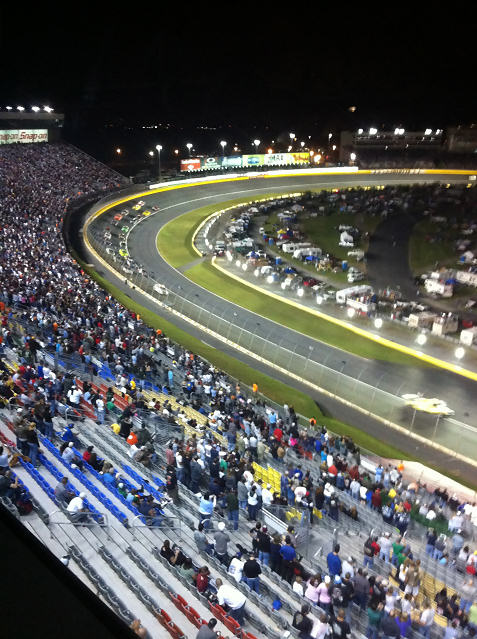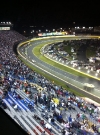NASCAR at Night: Bullz-Eye’s time at the Bank of America 500
When you think of NASCAR, you think of a few key images. First, there must be loud, fast, heavily stickered cars careening around an oval. Secondly, the race will probably take place somewhere in the south. And finally, there must be enough flowing Budweiser and blaring country music twang to annoy Toby Keith. Yes, these are stereotypes, but no one ever mentions just how much fun a NASCAR event is because of it. Bullz-Eye went to the Bank of America 500 in Charlotte as a guest of Valvoline to witness this circus in person.
NASCAR races, like horror movies, are better at night. The reason is the same, drama. The noises seem louder, the speed seems more intense, and the crowds become more restless with anticipation. And really it is the fans that make these events what they are. Their blind devotion to single drivers makes the most ardent sports team fan blush. Depending on their favorite driver’s success in the rest, certain sections of the track may be in utter despair and crazed happiness at the same time.
The venue is also crucial. Charlotte can be described as one of the cradles of NASCAR. This southern city not only contains the track, but the Roush Racing Team as well. With its southern charm, fantastic barbeque, and good times vibe, the city is the embodiment of NASCAR’s attitude.
Therefore, when the sun sets and the green flag drops, the raceway is filled to the brim with the noise of crowds and V8 engines. Whereas the sound of an IndyCar of F1 car can be described as the aural representation of precision, the NASCAR V8 is the opposite. Sounding as if a bear and a shark got into a fight while in an industrial cement mixer, the V8’s growl is a form of organized chaos. From there on out, it all comes down the preparation of the car.
There is nothing on this planet that is as complex and simple as a NASCAR racer. At first glance, these cars may seem barbaric: carburetors, pushrods, analog gauges, and a ducktail spoiler that seem ripped out of racing’s past. However, as Roush Fenway Racing shows, the technical precision needed to weld the frames together, tune the car for each track, and extract the most horsepower out of these engines is staggering. Not even the engine oil makes it into the car without rigorous testing.
For instance, when Valvoline wanted to use their new NextGen oil in Roush Fenway Racing’s cars, it had to be put through the ringer first. First, the oil is subjected to bench tests. This is when an engine is run at high RPM for hours at a time with the oil being tested in the crankcase. At the end of each test, the engine is taken apart and checked for wear and tear. From there the oil is put into running racecars and ran in torture tests on select NASCAR tracks. If it passes all barriers tests with flying marks, it is fit to be used in the car during the season. Valvoline NextGen did pass all these tests and is being used in Roush Fenway Racing’s cars this year in both the Nationwide and Sprint Car racing series. And if the oil is scrutinized this much, you can only imagine the tests needed for every single component of these racecars.
When all these elements come together come together at a race like the Bank of America 500, a good time is bound to be the result. To add to the excitement, this race took part during, “The Chase.” This is NASCAR’s playoff system where the top 10 drivers are stripped of their points and must duke it out for the last 10 races for the championship. A cage match with V8’s if you will.
After the dust settled, Roush driver Matt Kenseth took the win home. In that race winning motor was Valvoline NextGen oil. Surprisingly, the race was very clean with only a few accidents and most of the retirements coming from mechanical failure. One would think that the end of deadly racing was upon us. Tragically, they are not. One day later in IndyCar, driver Dan Wheldon would perish in a crash in Las Vegas. One week after that crash, rising star Marco Simoncelli would die in a crash during a MotoGP race. This all comes after racing in all leagues have become safer because of these tragic crashes. NASCAR’s current safety revolution can be attributed to Dale Earnhardt’s fatal crash at Daytona in 2001.
Even though leagues across the world try to make racing safer; at its core, motorsports is a dangerous job. It is with this in mind that everyone must respect the dangers that these drivers put themselves through in the pursuit of victory. It is this bravery that puts racing drivers ahead of many other sports, and brings fans the world over to the grandstands to see these men and women pit themselves and their machine against the clock without going over the edge. It doesn’t matter if you’re racing in NASCAR, F1, or a local dirt track race; racing is a sport of courage and talent for all those involved.
Related Posts
Posted in: Cars
Tags: autos, autos for guys, autos for men, Bank of America 500, car info for men, Dale Earnhardt, motor oil, NASCAR, The Chase, Valvoline, Valvoline NextGen















